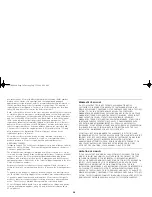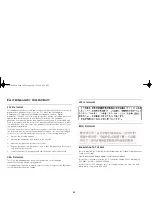
38
E
LECTROMAGNETIC
C
OMPATIBILITY
FCC S
TATEMENT
This equipment has been tested and found to comply with the limits for a Class B
digital device, pursuant to Part 15 of the FCC Rules, and the Canadian
Department of Communications Equipment Standards entitled, “Digital
Apparatus,” ICES-003. These limits are designed to provide reasonable protection
against harmful interference in a residential installation. This equipment
generates, uses and can radiate radio frequency energy and, if not installed and
used in accordance with the instructions, may cause harmful interference to radio
communications. However, there is no guarantee that interference will not occur
in a particular installation.
If this equipment does cause interference to radio or television reception, which
can be determined by turning the equipment off and on, the user is encouraged
to try to correct the interference by one or more of the following measures:
■
Reorient the receiving antenna.
■
Relocate the equipment with respect to the receiver.
■
Move the equipment away from the receiver.
■
Plug the equipment into a different outlet so that equipment and receiver are
on different branch circuits.
■
Consult the dealer or an experienced radio/television technician for help.
CSA S
TATEMENT
This Class B digital apparatus meets all requirements of the Canadian
Interference-Causing Equipment Regulations.
Cet appareil numérique de la classe B respecte toutes les exigences du Règlement
sur le matériel brouilleur du Canada.
VCCI S
TATEMENT
BCIQ S
TATEMENT
I
NFORMATION
T
O
T
HE
U
SER
The user may find the following booklet prepared by the Federal Communications
Commission helpful:
How to Identify and Resolve Radio-TV Interference Problems
This booklet is available from the U.S. Government Printing Office, Washington,
DC 20402, Stock No. 004-000-00345-4.
In order to meet FCC emissions limits, this equipment must be used only with
cables which comply with IEEE 802.3.
3C16700.book Page 38 Tuesday, July 13, 1999 9:59 AM



































